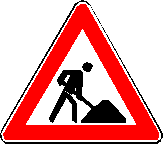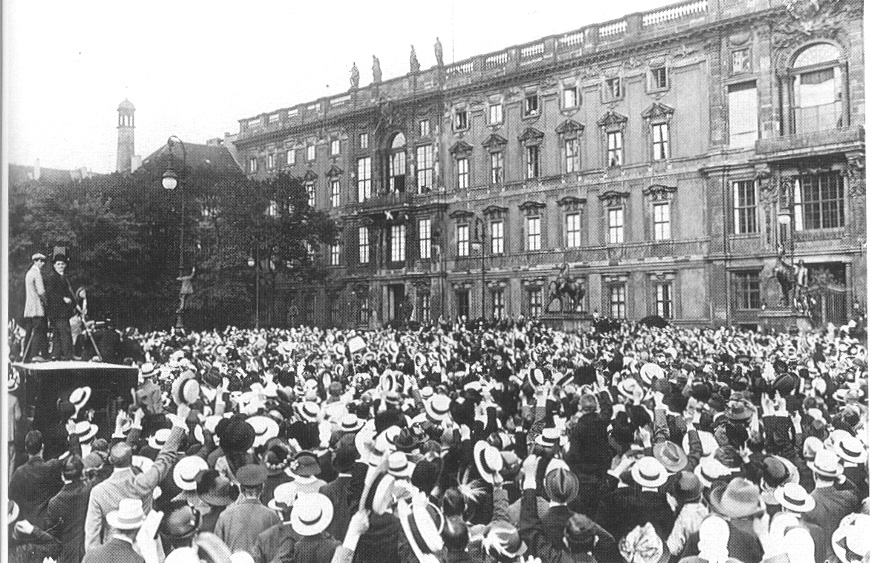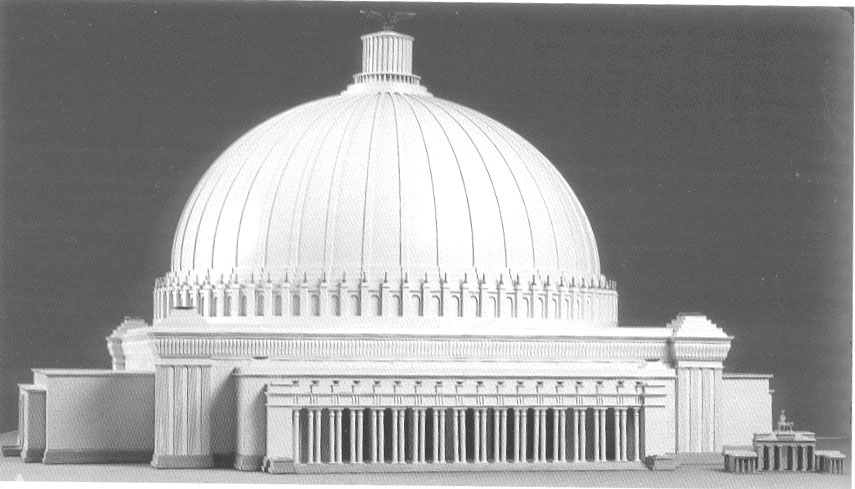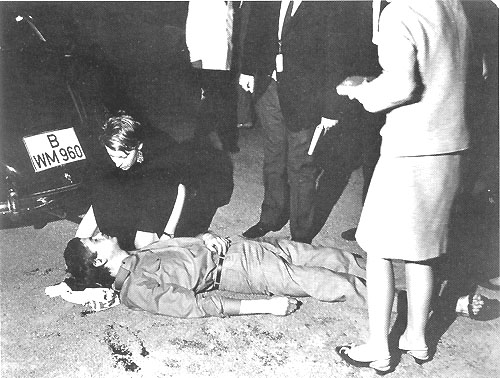
History
Under Construction

 |
HistoryUnder Construction |
 |
Founded, presumably, some 700-800 years ago (the exact date is uncertain), Berlin's golden age began at the end of the 19th century, when, in 1871, it became the capital of the newly unified German Empire. In the same year, Germany won the Franco-Prussian war, and a large part of the reparations paid by France were invested in Berlin.
As the city expanded and industrialized, an organized urban workers' movement gained more and more ground.
In 1914, at the beginning of the First World War, the emperor called on Germans to unite. In an allusion to the divided parliament, he stood on the balcony of his Berlin palace and proclaimed, "I know no parties, only Germans."
 |
Kaiser Wilhelm II. addresses his subjects in 1914, from the City Palace in Berlin. |
During the war, there was some degree of unity, more or less. After the war,
however, all the conflicts that had existed previously came to a head.
In 1918, at the end of World War One, facing defeat, the German emperor fled
to Holland. As the emperor fled, socialist leader Karl
Liebknecht (who, with Rosa Luxemburg, headed the Spartakus-Bund) stood on
the same balcony from which, four years earlier, the emperor had called for
German unity. Liebknecht now called
forth the German Socialist Republic. However, on the same day - November
9th, consistently an important date in German history - Philip Scheidemann
called forth the parliamentary republic. After several riots and insurrections,
the parliamentary republic carried the day, but its victory came at the expense
of the alienation of much of Berlin's working class, many of whom supported
the more radical brand of socialism espoused by the Communist Party.
The decades following World War One were marked by the city's growth and also a growing gulf between leisure-class urbanites and the industrial urban working class. Berlin became known both as a city of libertines and a hotbed of socialist radicalism (not for nothing was it sometimes referred to as "Rotes Berlin." Logically enough, support for the Nazis was lower here than anywhere else in Germany - though it still could not be considered low in any absolute sense. In the 1933 elections that brought Hitler to power, fully one quarter of Berlin's population voted for the vehemently (and often violently) anti-Nazi German Communist Party (twice the national average), while the percentage of Nazi voters, at 35%, was 10% lower than the national average. Even before 1945, Berlin was a city deeply divided, and anecdotal evidence seems to show that Berlin was both the Nazi capital and the capital of anti-Nazi resistance.
After the Nazis consolidated their power, they wanted to place their architectural stamp on Berlin, a city with which they had a somewhat antagonistic relationship. "Ihr werdet Berlin nicht wiedererkennen," Goebbels said of plans to remodel the capital - "You will not recognize Berlin."
 |
Albert Speer's planned capitol building. For a sense of scale, note the Brandenburg Gate, at the lower right. |
In spite of the fact that Albert Speer's truly megalomaniacal plan to remodel the entire city and rename it Germania was never instituted, a number of individual buildings were completed, and you can still see some fascist architecture in Berlin today, for instance, at Tempelhof Airport. Many of the debates about what is to be built now in Berlin center around how much contemporary conservative architecture echoes fascist themes. The Nazi headquarters were in Berlin, now the location of a museum and memorial site, the Topography of Terror, whose fate is uncertain.
The Holocaust, one of the central traumas of the 20th century, left its traces
on Berlin. Before the war, about 60,000 Jews lived in Berlin; after 1945, that
number had dwindled. The synagogue in the Oranienburger Straße escaped
the desctruction of Kristallnacht through the intervention of a courageous fireman,
though it was later desecrated, parts of it were destroyed, and it was used
to store Nazi weapons. The Prenzlauer Berg synagogue building survived only
because it stood so close to neighboring buildings that residents were afraid
that if they burned it down, their houses would burn as well.
The systematic destruction of the Jews was planned at the Wannsee Conference,
in a villa on Berlin's outskirts; the Sachsenhausen concentration camp is an
hour from the city center on the train. Debates about whether and how to memorialize
this past have been a fixture in postwar Berlin, from 1945 through the present
day.
During World War Two, large parts of the city were destroyed - about 600,000
housing units - and interestingly enough, it was working-class areas like Wedding
and Kreuzberg that sustained the heaviest damage, while richer areas like Charlottenburg
and Wannsee went relatively undamaged.
After the end of WWII, the city was split into four different administrative
parts, and in 1949, when the two German states were founded, were more or less
merged into two, although Berlin was still officially divided into French, American,
British and Soviet zones until 1991.
In the years between 1945 and 1989, Berlin became perhaps the primary showcase
of the Cold War. The determination of both the Eastern and Western blocs to
hold onto Berlin was demonstrated early on during the Berlin Blockade of 1948-49,
when the Soviet Union closed land access to Berlin and the Western "Raisin
Bombers" flew food and fuel to the blockaded city for almost a year. Both
the West and East German governments subsidized Berlin far more heavily than
any other city, well aware of the city's symbolic value. In spite of the efforts
at rebuilding, ruins marked the landscape of both Berlins for decades, and even
today you will see walls filled with bulletholes. Two prominent buildings in
the West remain purposefully in ruins.
In the East, the royal palace, heavily damaged by bombs, was destroyed in 1950.
In its place a glass-and-stone Palace of the Republic was built, which housed
the East German parliament as well as restaurants and bowling alleys for use
by common citizens. Only one part of the royal palace was saved, as part of
the East German effort to replace many of the imperial markers with socialist
ones - the balcony from which Liebknecht called forth the socialist republic.
Meanwhile, particularly in the 1950s, so-called Plattenbauten began to dominate
the residential landscape - strapped for cash, the government built low-quality
but high-residency prefab apartment buildings. In 1953, the first and, for decades,
last major anti-government protest occurred, as thousands of workers took to
the streets to protest poor working conditions - a major embarrassment to the
socialist state. The protests ended violently; exact numbers have never been
given, but even the official figures listed 21 dead and 187 injured, not to
mention about 13,000 imprisoned.
West Berlin, meanwhile, benefited from the "Wirtschaftswunder," the
upswing in the economy in the 1950s, a decade of rebuilding and prosperity.
The West German capital was moved to Bonn for the next 50 years, and in the
wake of the Blockade, Berlin was considered a risky investment. It was subsidized
heavily by the government, which offered generous incentives for people to move
to Berlin. With the institution of mandatory military service in West Germany
in 1956, Berlin also became a haven for peaceniks, as Berlin residents were
exempt from this service.
In August 1961, the Wall was erected, in large part as a response to growing
discontent within the GDR and the increasing flight of East Germans to the West.
It is no exaggeration to say that this event shocked much of the world, not
only for its audacity but also for its unexpectedness; the Wall was erected
almost overnight. It too became a heavily symbolic location for conflict between
the East and the West. Few believed the East German government's claims that
the Wall was built to protect the GDR from the fascist West, particularly given
the number of escapes and attempted escapes by Easterners. John F Kennedy made
history in his 1963 "I am a Berliner"
speech.
Particularly in the 1970s and 1980s, the area around the Wall became a favorite
location of leftist protestors. The Wall had been built in the Soviet sector,
and the borders of the Soviet sector extended about five feet beyond the Wall.
Practically, this area was a no-man's land, where Western police had no jurisdiction.
Occasionally, protesters actually jumped over the Wall into the East, where
they were generally greeted cordially, given coffee, and escorted back to the
border (the East seeing this, understandably, as a fine chance for propaganda).
The collapse of the GDR was not only an ideological challenge for the German
left, but a practical challenge for the radical movements in Berlin.
The graffiti on the Western side of the Wall was also a vast blank canvas for
art and ideological critique.
In the 1960s and 1970s, West Berlin was once again known as the leftist city.
Years of anti-military migration contributed to the formation of a substantial,
radically leftist student movement. Protesters were habitually met with the
phrase, "Geh doch rüber!" - "Just go over there!" -
and police were often brutal, even firing on crowds. (Benno Ohnesorg's shooting
in 1967 in Berlin had much the same impact as Kent State did in this country.)
 |
Benno Ohnesorg, shot in the back by police at a protest against the Shah of Iran in 1967 |
The late 1970s and 1980s were relatively quiescent; as the Western and Eastern
blocs slowly moved toward détente, Berlin's symbolism was more uncomfortable
for both sides. This remained the case until 1988-9, when months-long anti-government
protests in East Berlin resulted in the Wall not falling but being surmounted.
The pictures of Berliners celebrating atop the Wall in November 1989 are perhaps
the most prominent images of the eventual fall of the Eastern Bloc.
Berlin is also a city of immigrants, and an ideological battle around issues
of immigration is being fought at all levels. The city's population is over
10% "foreign," in some areas so-called foreigners make up almost half
the population. Still, many politicians refuse to see Germany as a site for
immigration; nevertheless, the city's enormous construction boom lives off the
work of illegally immigrated laborers. Immigrants come primarily from Turkey
and the former Eastern Bloc, but there are substantial minorities of African
and Latin American immigrants as well. (European Union citizens aren't usually
considered immigrants.]
Now, Berlin is again the site of ideological and architectural battles. Constant
debates surround the issue of how the New Germany should be represented. Major
new building has taken place, both privately and publicly. I left town for three
weeks once and when I returned, an old building on the corner by my subway stop
had been replaced by a new hotel. There was nearly a decade of debate on whether
a Holocaust memorial should be built and if so, how and where; a similarly contentious
debate surrounded the Palast of the Republic and whether it should be destroyed
and if so, whether the old Royal Palast should be rebuilt in its place. Both
of these questions, while they have received several different parliamentary
answers, do not seem to have been finally settled. Christo's Wrapped Reichstag
project (June 1995) foregrounded a lot of these questions, enclosing the old
parliament in thousands of meters of gauze while the national parliament in
Bonn decided what to do with it. Many of the battles are also fought over street
names. Street names in Germany, and especially in Berlin, are extremely political.
The West, for example, named one of its major streets "Street of the 16.
June," the date of the workers' uprising in Berlin, while the East named
its streets after communist leaders like Lenin and Ho Chi Minh. City plans from
the different eras of Berlin are fascinating, as streets go through continual
renamings - Kaiser-Wilhelm-Platz to Schloßplatz to Marx-Engels-Platz,
and now many of the socialist street names are being reconsidered - often to
severe opposition.
Berlin is in many ways a physical representation of many of the 20th century's major ideologies and events, events that often called into question precisely those ideas of modernity that were developed in the 19th century. It is also a site of constant struggle, from 1871 to the present day, to define what a nation is, and what the German nation in particular is and is not. Particularly now that most of the government has been moved to Berlin, it is once again a heavily contested site. The new office of the chancellor was built, many critics say, with a fear of the people in mind, and this antagonistic relationship between the people and the government is also one of the markers of Berlin.